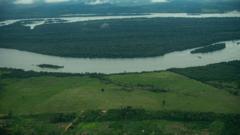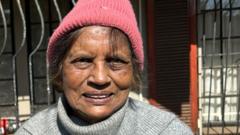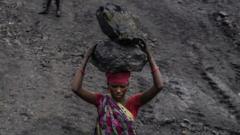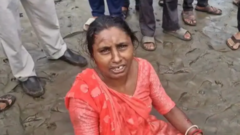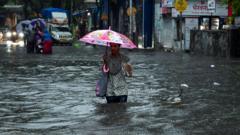Despite proximity to a major solar energy facility, the community remains disconnected from the power grid, grappling with the consequences of energy inequality.
**In the Shadows of Solar Power: Pampa Clemesí's Plight**
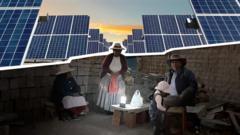
**In the Shadows of Solar Power: Pampa Clemesí's Plight**
Residents of a village beside Peru's largest solar complex are left without electricity, highlighting a paradox in renewable energy distribution.
In the heart of southern Peru, the remote village of Pampa Clemesí presents a stark contrast to the promise of renewable energy. Each dawn, Rosa Chamami rises to cook with flames ignited from cardboard scraps. These scraps come from boxes that once encased 800,000 solar panels, now operational at the nearby Rubí plant, part of a vast solar complex—the largest in Peru and a significant player in Latin America.
Despite its proximity to the Rubí solar plant, located a mere 600 meters from her home, Pampa Clemesí—and its 150 residents—lives in total darkness, disconnected from the energy grid it helps power. Although the plant generates about 440 GWh of electricity annually—enough to service 351,000 homes—Rosa and her neighbors rely on battery-powered torches for illumination.
The village boasts one of the best solar energy sites, basking in over 3,200 hours of sunshine yearly. Yet, the disconnection reflects systemic failures poised against a backdrop of rapid renewable energy growth in Peru. Electricity generation from renewables saw an astonishing 96% spike in 2024 alone. Carlos Gordillo, an energy expert, attributes this gap to a profit-centric system that neglects rural electrification.
Orygen, the plant's operator, maintains it has made significant progress towards bringing power to the village. The company completed building a dedicated power line and installed infrastructure, including 53 power towers, at a cost of $800,000. However, the final connection relies on the Ministry of Mines and Energy, which has delayed the necessary wiring for individual homes.
Residents face profound daily challenges. The absence of electricity severely limits their lifestyle—Rosa's home lacks sockets, and she often seeks others' electricity to charge her phone. Only a handful of villagers possess solar panels from Orygen, but financial constraints prevent them from affording the necessary batteries and converters. A small group enjoys limited power, relying on solar for less than half a day.
With no sewage or waste management, the village's infrastructure is in disrepair. Following the COVID-19 pandemic, Pampa Clemesí's population has dwindled. Pedro Chará, a long-time resident, laments the lack of resources, echoing a collective exhaustion from years of waiting for basic needs—electricity, water—in a community shaped by discarded construction from the solar plant itself.
Even daily meals revolve around the situation; without refrigeration, limited to gas when finances allow, residents share simple food in the dark, illuminated only by a flickering solar-powered torch.
As night envelops Pampa Clemesí, the residents gather for their last meal in ideal darkness. "Our only light is these little torches," Rosa states. Despite their hardships, a flicker of hope remains: "If we had electricity, people would come back."
Winds lift dust from the streets, and lampposts sit idle, awaiting installation. Villagers await a promise of progress, choosing to endure invisibly in the shadow of a resource that, paradoxically, shines brightly in their midst. For them, the answer to their struggle lies in an enduring relationship with the sun—an unwavering source of light and warmth amid unremitting darkness.
Despite its proximity to the Rubí solar plant, located a mere 600 meters from her home, Pampa Clemesí—and its 150 residents—lives in total darkness, disconnected from the energy grid it helps power. Although the plant generates about 440 GWh of electricity annually—enough to service 351,000 homes—Rosa and her neighbors rely on battery-powered torches for illumination.
The village boasts one of the best solar energy sites, basking in over 3,200 hours of sunshine yearly. Yet, the disconnection reflects systemic failures poised against a backdrop of rapid renewable energy growth in Peru. Electricity generation from renewables saw an astonishing 96% spike in 2024 alone. Carlos Gordillo, an energy expert, attributes this gap to a profit-centric system that neglects rural electrification.
Orygen, the plant's operator, maintains it has made significant progress towards bringing power to the village. The company completed building a dedicated power line and installed infrastructure, including 53 power towers, at a cost of $800,000. However, the final connection relies on the Ministry of Mines and Energy, which has delayed the necessary wiring for individual homes.
Residents face profound daily challenges. The absence of electricity severely limits their lifestyle—Rosa's home lacks sockets, and she often seeks others' electricity to charge her phone. Only a handful of villagers possess solar panels from Orygen, but financial constraints prevent them from affording the necessary batteries and converters. A small group enjoys limited power, relying on solar for less than half a day.
With no sewage or waste management, the village's infrastructure is in disrepair. Following the COVID-19 pandemic, Pampa Clemesí's population has dwindled. Pedro Chará, a long-time resident, laments the lack of resources, echoing a collective exhaustion from years of waiting for basic needs—electricity, water—in a community shaped by discarded construction from the solar plant itself.
Even daily meals revolve around the situation; without refrigeration, limited to gas when finances allow, residents share simple food in the dark, illuminated only by a flickering solar-powered torch.
As night envelops Pampa Clemesí, the residents gather for their last meal in ideal darkness. "Our only light is these little torches," Rosa states. Despite their hardships, a flicker of hope remains: "If we had electricity, people would come back."
Winds lift dust from the streets, and lampposts sit idle, awaiting installation. Villagers await a promise of progress, choosing to endure invisibly in the shadow of a resource that, paradoxically, shines brightly in their midst. For them, the answer to their struggle lies in an enduring relationship with the sun—an unwavering source of light and warmth amid unremitting darkness.



